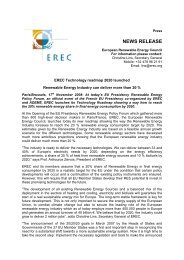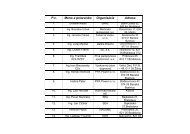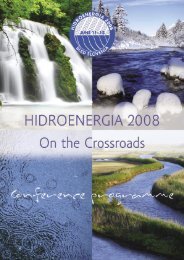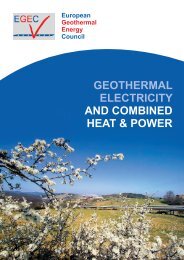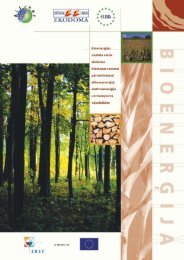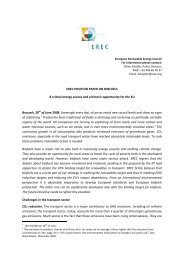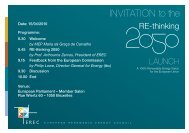English version - European Renewable Energy Council
English version - European Renewable Energy Council
English version - European Renewable Energy Council
Create successful ePaper yourself
Turn your PDF publications into a flip-book with our unique Google optimized e-Paper software.
C O N F E R E N C E P R O G R A M M EThis session should focus on existing experiences and onnew proposals for national and local policies and actions,which could help to remove some of the barriers identifiedabove. It should lead to recommendations for policiesand programmes which can be implemented at EU,National and local levels to share experiences, and toencourage the relevant decision makers to tackle theadministrative barriers which are slowing the growth ofrenewable electricity markets in the EU today.“Community resources in conventional primaryenergy cannot, at their current stage ofdevelopment, form the basis for <strong>European</strong>energy self-sufficiency. Only technology intensiverenewable resources can help mitigatethe present trend towards increasing energydependence.”“Towards a <strong>European</strong> strategy for the securityof energy supply”, <strong>European</strong> Commission, 2000What are the most successful national policiesand actions for addressing issues overcomingthe five barriers which are identified in the EUDirective - such as application procedures forfinancial support, administrative proceduresfor planning and building approvals, guaranteesof origin, transparency of grid connectioncosts, and access to electricity grids?What are the most effective ways to raise publicawareness of the benefits of RES electricity?Are there other important barriers to thehigher market penetration of RES electricity?Are there special barriers to be overcome,when connecting small generators(eg photovoltaic, biomass) to the grid?Will new barriers arise as the percentage ofrenewable electricity in the grid increases?What should be the policy of grid regulatorsconcerning decentralised electricity supplythe diversity of electricity supply, and themaximum percentage of renewable electricityon the grid?Panel 2b:SUPPORTING RENEWABLES ELECTRICITYIN THE MARKET - WHICH ARE THE BESTSUPPORT-SCHEMES FOR RES-ELECTRICITYAPPLIED IN EUROPE?Investment decisions depend both on the level of financialsupport and on the stability of promotion schemes,since investors require a return on their investmentwith an acceptable level of risk. This implies that supportmechanisms should not be changed too frequently,and that they should be underwritten for an adequateperiod of time to secure the expected returns oninvestment, in order to encourage new investments inrenewable electricity generation.In the Union’s context, the environmental State Aid rulespermit a relatively wide range of support schemes forpromoting energy efficiency and renewables and the<strong>Renewable</strong> <strong>Energy</strong> Electricity Directive, while not providingfor a harmonised support scheme, allows andencourages Member States to promote the productionof electricity from renewables Five main types of financialsupport scheme are currently applied in Europe,namely feed-in tariffs, obligations with tradable certificates,tax relief, capital subsidies, and competitive tenderingschemes.The <strong>Renewable</strong> Electricity directive permits the memberstates to set up support schemes, while not providing fora harmonised support scheme. Until now, feed-in tariffshave shown themselves to be the most effective for promotingrapid growth in new renewable electricity markets.However, feed-in tariffs are criticised for not providinga sufficiently strong incentive for cost reduction. Thechallenge would be to find ways in which feed-in tariffssystems could evolve to remain an economically acceptablelong-term solution for supplying markets with asubstantial percentage of renewable electricity.Tradable certificate schemes are expected to have astronger impact on cost reduction, because they shouldencourage more competition in the market. However,certificate schemes are criticised for not providing asufficiently low risk opportunity for investors, since themarket for certificates is not yet fully developed. Themarket for certificates could of course mature in thefuture, and might offer other benefits, for example byfacilitating international trading in renewable electricity,and monitoring guarantees of origin.S U P P O R T I N G R E N E W A B L E S E L E C T R I C I T Y - P A N E L 2 b13


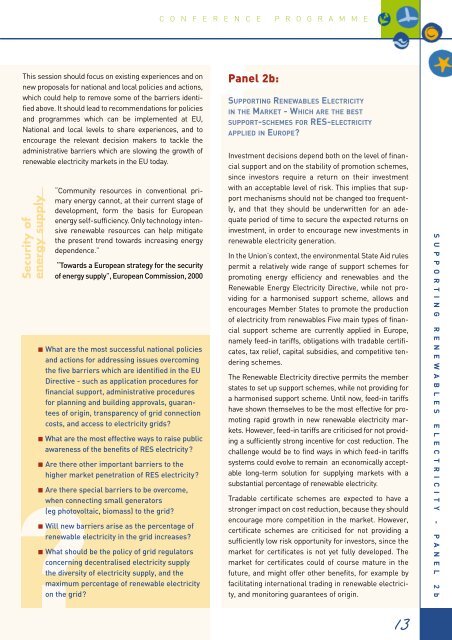
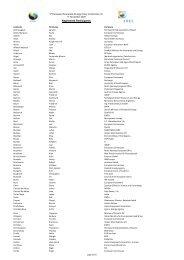
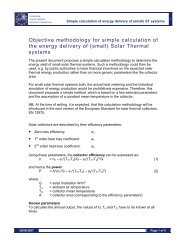

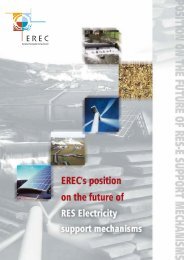
![Energy [R]evolution - Greenpeace](https://img.yumpu.com/47174859/1/184x260/energy-revolution-greenpeace.jpg?quality=85)
